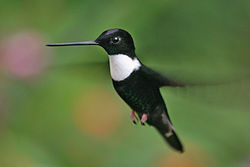| Coeligena | |
|---|---|
 | |
| Collared inca (C. torquata) | |
| Scientific classification | |
| Kingdom: | Animalia |
| Phylum: | Chordata |
| Class: | Aves |
| Clade: | Strisores |
| Order: | Apodiformes |
| Family: | Trochilidae |
| Tribe: | Heliantheini |
| Genus: | Coeligena Lesson, 1833 |
| Type species | |
| Ornismya coeligena [1] Lesson, 1833 | |
| Species | |
see text | |
Coeligena is a genus of South American hummingbirds.





















